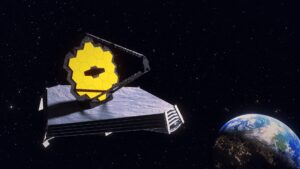 The James Webb Space Telescope (sometimes called JWST or Webb) is an orbiting infrared observatory that will complement and extend the discoveries of the Hubble Space Telescope, with longer wavelength coverage and greatly improved sensitivity.
The James Webb Space Telescope (sometimes called JWST or Webb) is an orbiting infrared observatory that will complement and extend the discoveries of the Hubble Space Telescope, with longer wavelength coverage and greatly improved sensitivity.
The longer wavelengths enable Webb to look much closer to the beginning of time and to hunt for the unobserved formation of the first galaxies, as well as to look inside dust clouds where stars and planetary systems are forming today.
It was launched on December 25, 2021. It is not in orbit around the Earth, like the Hubble Space Telescope is – it will actually orbit the Sun, (solar orbit) 1.5 million / kilometres (1 million miles) away from the Earth at what is called the second Lagrange point or L2.
What is special about this orbit is that it lets the telescope stay in line with the Earth as it moves around the Sun. This allows the satellite’s large sunshield to protect the telescope from the light and heat of the Sun and Earth, and Moon.
Its mission goals are:
Have a look at some of these great videos:
The James Webb Space Telescope Explained In 9 Minutes
James Webb Space Telescope Launch and Deployment
‘Incredible’ Jupiter views revealed by James Webb Space Telescope – BBC News
New image from James Webb Telescope shows star about to become supernova
The Insane Engineering of James Webb Telescope
Contacting us is easy, simply complete the form below.
Standard delivery ships in 2-4 working days.
Please allow up to 4 weeks for international orders to arrive (we are working very hard to reduce this time).
FREE on all orders over £25.00;
£3.95 for orders under £25.00;